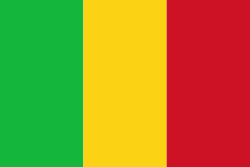Gao
Gao, or Gawgaw/Kawkaw, is a city in Mali and the capital of the Gao Region. The city is located on the River Niger, 320 km east-southeast of Timbuktu on the left bank at the junction with the Tilemsi valley.
For much of its history Gao was an important commercial centre involved in the trans-Saharan trade. In the 9th century external Arabic writers described Gao as an important regional power, and by the end of the 10th century, the local ruler was said to be a Muslim. Towards the end of the 13th century Gao became part of the Mali Empire, but in first half of the 15th century the town regained its independence and with the conquests of Sunni Ali (ruled 1464–1492) it became the capital of the Songhai Empire. The Empire collapsed after the Moroccan invasion in 1591 and the invaders chose to make Timbuktu their capital. By the time of Heinrich Barth's visit in 1854, Gao had declined to become an impoverished village with 300 huts constructed from matting. In 2009, the urban commune had a population of 86,633.
On 31 March 2012, Gao was captured from Malian government forces by National Movement for the Liberation of Azawad (MNLA) and Ansar Dine rebels. After the additional captures of Kidal and Timbuktu, on 6 April, the MNLA declared the region independent of Mali as the nation of Azawad and named Gao its capital. The MNLA lost control to Islamist militias after the Battle of Gao on 26 and 27 June 2012. On 26 January 2013, the city was recaptured by French military forces as part of Opération Serval.
For much of its history Gao was an important commercial centre involved in the trans-Saharan trade. In the 9th century external Arabic writers described Gao as an important regional power, and by the end of the 10th century, the local ruler was said to be a Muslim. Towards the end of the 13th century Gao became part of the Mali Empire, but in first half of the 15th century the town regained its independence and with the conquests of Sunni Ali (ruled 1464–1492) it became the capital of the Songhai Empire. The Empire collapsed after the Moroccan invasion in 1591 and the invaders chose to make Timbuktu their capital. By the time of Heinrich Barth's visit in 1854, Gao had declined to become an impoverished village with 300 huts constructed from matting. In 2009, the urban commune had a population of 86,633.
On 31 March 2012, Gao was captured from Malian government forces by National Movement for the Liberation of Azawad (MNLA) and Ansar Dine rebels. After the additional captures of Kidal and Timbuktu, on 6 April, the MNLA declared the region independent of Mali as the nation of Azawad and named Gao its capital. The MNLA lost control to Islamist militias after the Battle of Gao on 26 and 27 June 2012. On 26 January 2013, the city was recaptured by French military forces as part of Opération Serval.
Map - Gao
Map
Country - Mali
 |
|
| Flag of Mali | |
Present-day Mali was once part of three extremely powerful and wealthy West African empires that controlled trans-Saharan trade: the Ghana Empire (for which Ghana is named), the Mali Empire (for which Mali is named), and the Songhai Empire. At its peak in 1300, the Mali Empire was the wealthiest country in Africa, covering an area about twice the size of modern-day France and stretched to the west coast of the continent. Mali was also one of the wealthiest countries on earth, and its emperor at its zenith, Mansa Musa, is believed to be possibly the wealthiest individual in history. Besides being an economic powerhouse, medieval Mali was a centre of Islam, culture and knowledge, with Timbuktu becoming a renowned place of learning with its university, one of the oldest in the world still active. The expanding Songhai Empire absorbed the empire in 1468, followed by a Saadian army which defeated the Songhai in 1591. In the late 19th century, during the Scramble for Africa, France seized control of Mali, making it a part of French Sudan. French Sudan (then known as the Sudanese Republic) joined with Senegal in 1959, achieving independence in 1960 as the Mali Federation. Shortly thereafter, following Senegal's withdrawal from the federation, the Sudanese Republic declared itself the independent Republic of Mali. After a long period of one-party rule, a coup in 1991 led to the writing of a new constitution and the establishment of Mali as a democratic, multi-party state.
Currency / Language
| ISO | Currency | Symbol | Significant figures |
|---|---|---|---|
| XOF | West African CFA franc | Fr | 0 |
| ISO | Language |
|---|---|
| BM | Bambara language |
| FR | French language |















